高中英语语法归纳总结:介词
- 格式:docx
- 大小:19.48 KB
- 文档页数:6
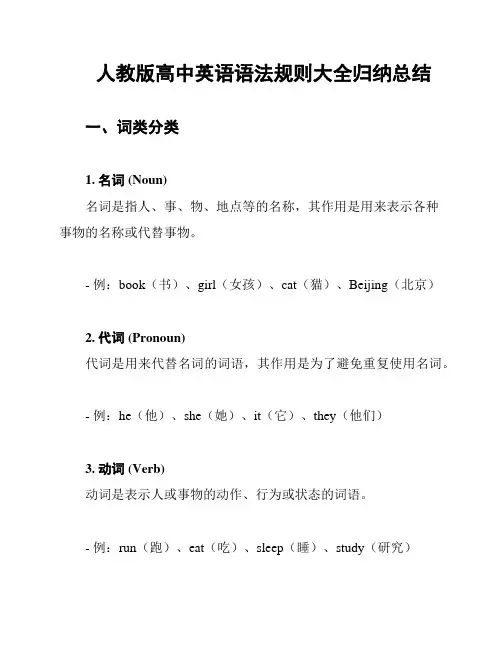
人教版高中英语语法规则大全归纳总结一、词类分类1. 名词 (Noun)名词是指人、事、物、地点等的名称,其作用是用来表示各种事物的名称或代替事物。
- 例:book(书)、girl(女孩)、cat(猫)、Beijing(北京)2. 代词 (Pronoun)代词是用来代替名词的词语,其作用是为了避免重复使用名词。
- 例:he(他)、she(她)、it(它)、they(他们)3. 动词 (Verb)动词是表示人或事物的动作、行为或状态的词语。
- 例:run(跑)、eat(吃)、sleep(睡)、study(研究)4. 形容词 (Adjective)形容词是用来形容名词或代词的词语,其作用是为了更准确地描述事物的特征或性质。
- 例:happy(快乐的)、beautiful(美丽的)、big(大的)、smart(聪明的)5. 副词 (Adverb)副词是用来修饰动词、形容词或其他副词的词语,其作用是为了更准确地描述行为、方式或程度。
- 例:quickly(快速地)、very(非常)、often(经常)、always(总是)6. 介词 (Preposition)介词是连接名词、代词等与其修饰的词语之间关系的词语。
- 例:in(在…里)、on(在…上)、at(在…处)、under (在…下)7. 连词 (Conjunction)连词是用来连接词与词、词组与词组或者句子与句子之间关系的词语。
- 例:and(和)、but(但是)、or(或者)、because(因为)8. 数词 (Numeral)数词是表示数量、次序或比例等概念的词语。
- 例:one(一)、first(第一)、half(一半)、quarter(四分之一)9. 冠词 (Article)冠词是用来限定名词的词语。
- 例:a/an(一个)、the(这个)二、句子成分1. 主语 (Subject)主语是句子中的核心成分,它通常是动作发出者或者是动作所作用的对象。
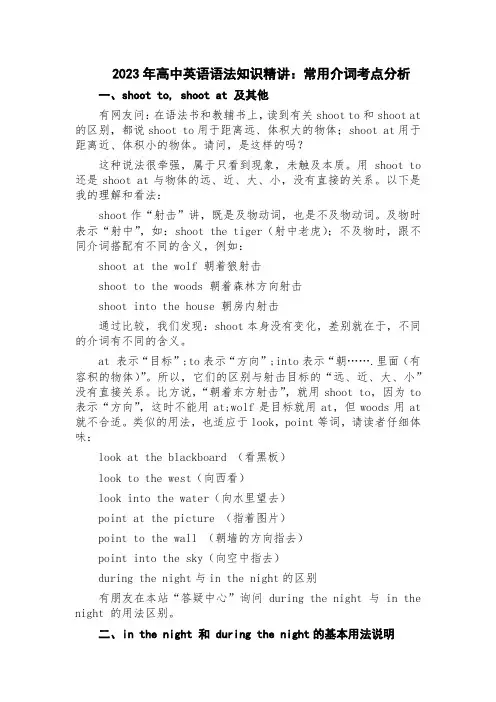
2023年高中英语语法知识精讲:常用介词考点分析一、shoot to, shoot at 及其他有网友问:在语法书和教辅书上,读到有关shoot to和shoot at 的区别,都说shoot to用于距离远、体积大的物体;shoot at用于距离近、体积小的物体。
请问,是这样的吗?这种说法很牵强,属于只看到现象,未触及本质。
用shoot to 还是shoot at与物体的远、近、大、小,没有直接的关系。
以下是我的理解和看法:shoot作“射击”讲,既是及物动词,也是不及物动词。
及物时表示“射中”,如:shoot the tiger(射中老虎);不及物时,跟不同介词搭配有不同的含义,例如:shoot at the wolf 朝着狼射击shoot to the woods 朝着森林方向射击shoot into the house 朝房内射击通过比较,我们发现:shoot本身没有变化,差别就在于,不同的介词有不同的含义。
at 表示“目标”;to表示“方向”;into表示“朝…….里面(有容积的物体)”。
所以,它们的区别与射击目标的“远、近、大、小”没有直接关系。
比方说,“朝着东方射击”,就用shoot to,因为to 表示“方向”,这时不能用at;wolf是目标就用at,但woods用at 就不合适。
类似的用法,也适应于look,point等词,请读者仔细体味:look at the blackboard (看黑板)look to the west(向西看)look into the water(向水里望去)point at the picture (指着图片)point to the wall (朝墙的方向指去)point into the sky(向空中指去)during the night与in the night的区别有朋友在本站“答疑中心”询问 during the night 与 in the night 的用法区别。
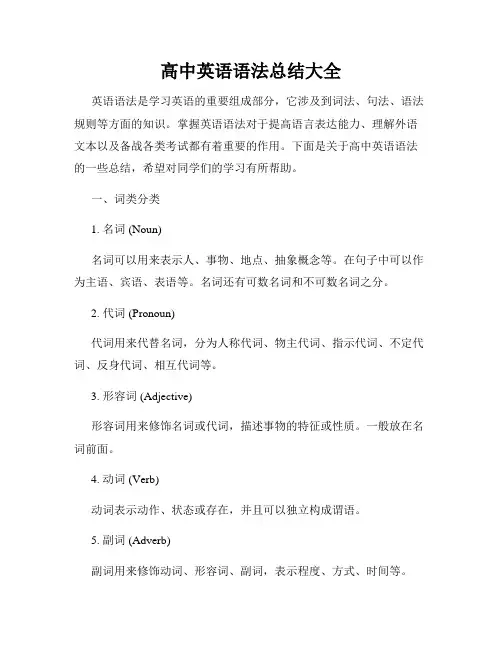
高中英语语法总结大全英语语法是学习英语的重要组成部分,它涉及到词法、句法、语法规则等方面的知识。
掌握英语语法对于提高语言表达能力、理解外语文本以及备战各类考试都有着重要的作用。
下面是关于高中英语语法的一些总结,希望对同学们的学习有所帮助。
一、词类分类1. 名词 (Noun)名词可以用来表示人、事物、地点、抽象概念等。
在句子中可以作为主语、宾语、表语等。
名词还有可数名词和不可数名词之分。
2. 代词 (Pronoun)代词用来代替名词,分为人称代词、物主代词、指示代词、不定代词、反身代词、相互代词等。
3. 形容词 (Adjective)形容词用来修饰名词或代词,描述事物的特征或性质。
一般放在名词前面。
4. 动词 (Verb)动词表示动作、状态或存在,并且可以独立构成谓语。
5. 副词 (Adverb)副词用来修饰动词、形容词、副词,表示程度、方式、时间等。
6. 介词 (Preposition)介词用来表示名词与其他词语之间的关系,常用的有in、on、at、to等。
7. 连词 (Conjunction)连词用来连接词语、短语或句子,分为并列连词、从属连词和连接副词。
8. 冠词 (Article)冠词分为定冠词和不定冠词,用来修饰名词,表示特指和泛指的概念。
9. 数词 (Numeral)数词用来表示数字,分为基数词和序数词。
二、主谓一致主谓一致是指主语与谓语在人称和数上保持一致。
主要涉及到以下几个方面:1. 单数主语与单数谓语动词搭配,复数主语与复数谓语动词搭配。
2. 不可数名词作为主语时,谓语动词使用单数形式。
3. 连词and连接的两个主语为复数,谓语动词使用复数形式。
三、时态和语态1. 一般现在时 (Simple Present Tense)表示现在经常或反复发生的动作、状态或真理等。
2. 一般过去时 (Simple Past Tense)表示过去某个时间发生的动作或状态。
3. 一般将来时 (Simple Future Tense)表示将来要发生的动作或状态。
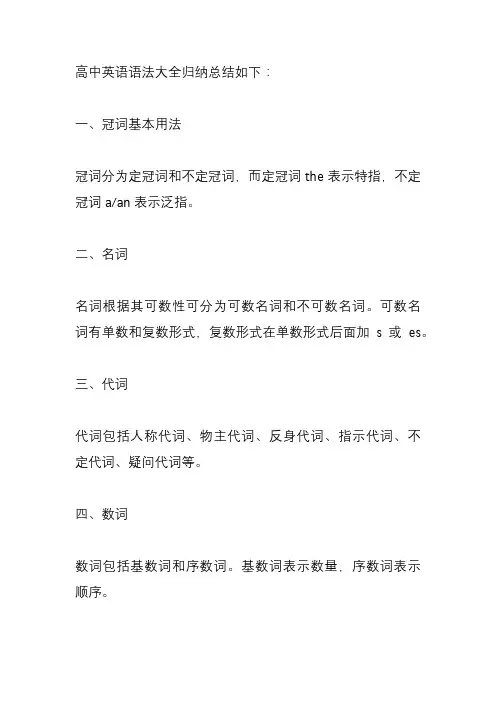
高中英语语法大全归纳总结如下:
一、冠词基本用法
冠词分为定冠词和不定冠词,而定冠词the表示特指,不定冠词a/an表示泛指。
二、名词
名词根据其可数性可分为可数名词和不可数名词。
可数名词有单数和复数形式,复数形式在单数形式后面加s或es。
三、代词
代词包括人称代词、物主代词、反身代词、指示代词、不定代词、疑问代词等。
四、数词
数词包括基数词和序数词。
基数词表示数量,序数词表示顺序。
五、形容词和副词
形容词用来修饰名词,表示名词的性质或特征。
副词用来修饰动词、形容词或其他副词。
六、介词
介词在句子中表示名词或代词与其他词之间的关系。
常用的介词有in、on、at、of等。
七、连词
连词用于连接句子中的两个或多个部分,表示它们之间的关系。
常用的连词有and、or、but等。
八、动词
动词是句子中的主要动作,有现在时、过去时、将来时等时态,还有肯定、否定、第三人称等形式。
以上是高中英语语法的大致归纳总结,具体内容可能因教材版本和教师的要求而有所不同。
建议结合教材和教师讲
解进行深入学习。
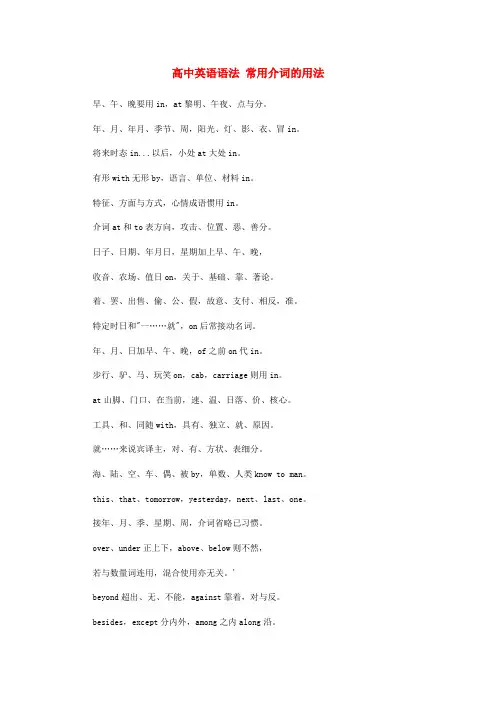
高中英语语法常用介词的用法早、午、晚要用in,at黎明、午夜、点与分。
年、月、年月、季节、周,阳光、灯、影、衣、冒in。
将来时态in...以后,小处at大处in。
有形with无形by,语言、单位、材料in。
特征、方面与方式,心情成语惯用in。
介词at和to表方向,攻击、位置、恶、善分。
日子、日期、年月日,星期加上早、午、晚,收音、农场、值日on,关于、基础、靠、著论。
着、罢、出售、偷、公、假,故意、支付、相反,准。
特定时日和"一……就",on后常接动名词。
年、月、日加早、午、晚,of之前on代in。
步行、驴、马、玩笑on,cab,carriage则用in。
at山脚、门口、在当前,速、温、日落、价、核心。
工具、和、同随with,具有、独立、就、原因。
就……来说宾译主,对、有、方状、表细分。
海、陆、空、车、偶、被by,单数、人类know to man。
this、that、tomorrow,yesterday,next、last、one。
接年、月、季、星期、周,介词省略已习惯。
over、under正上下,above、below则不然,若与数量词连用,混合使用亦无关。
'beyond超出、无、不能,against靠着,对与反。
besides,except分内外,among之内along沿。
同类比较except,加for异类记心间。
原状because of,、 owing to、 due to表语形容词under后接修、建中,of、from物、化分。
before、after表一点, ago、later表一段。
before能接完成时,ago过去极有限。
since以来during间,since时态多变换。
与之相比beside,除了last but one。
复不定for、找、价、原,对、给、段、去、为、作、赞。
快到、对、向towards,工、学、军、城、北、上、南。
but for否定用虚拟,复合介词待后言。
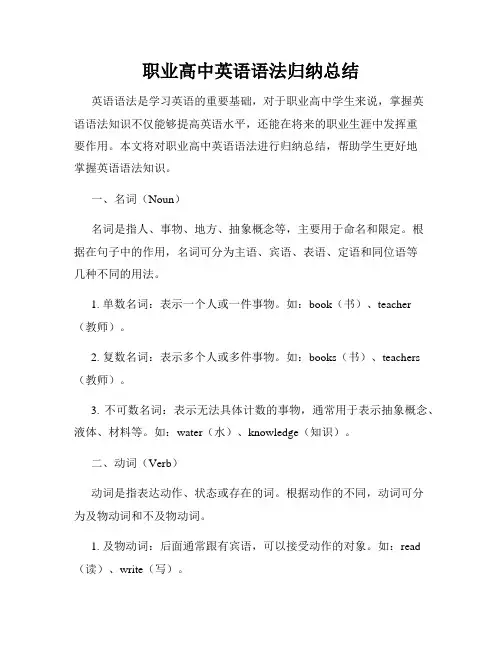
职业高中英语语法归纳总结英语语法是学习英语的重要基础,对于职业高中学生来说,掌握英语语法知识不仅能够提高英语水平,还能在将来的职业生涯中发挥重要作用。
本文将对职业高中英语语法进行归纳总结,帮助学生更好地掌握英语语法知识。
一、名词(Noun)名词是指人、事物、地方、抽象概念等,主要用于命名和限定。
根据在句子中的作用,名词可分为主语、宾语、表语、定语和同位语等几种不同的用法。
1. 单数名词:表示一个人或一件事物。
如:book(书)、teacher(教师)。
2. 复数名词:表示多个人或多件事物。
如:books(书)、teachers (教师)。
3. 不可数名词:表示无法具体计数的事物,通常用于表示抽象概念、液体、材料等。
如:water(水)、knowledge(知识)。
二、动词(Verb)动词是指表达动作、状态或存在的词。
根据动作的不同,动词可分为及物动词和不及物动词。
1. 及物动词:后面通常跟有宾语,可以接受动作的对象。
如:read (读)、write(写)。
2. 不及物动词:后面通常没有宾语,表示主语的动作。
如:sleep(睡觉)、run(跑)。
三、形容词(Adjective)形容词是用来修饰名词或代词的词。
它可以表示事物的性质、状态、特征等。
1. 基本形容词:用来表示事物的一般属性。
如:big(大)、beautiful(美丽)。
2. 比较级形容词:用来表示两个事物之间比较的关系。
如:bigger (更大)、more beautiful(更美丽)。
3. 最高级形容词:用来表示三个或三个以上事物之间比较的关系。
如:biggest(最大的)、most beautiful(最美丽的)。
四、副词(Adverb)副词是用来修饰动词、形容词和其他副词的词。
它可以表示时间、地点、方式、程度等。
1. 时间副词:表示动作的时间。
如:now(现在)、soon(很快)。
2. 地点副词:表示动作的地点。
如:here(这里)、there(那里)。
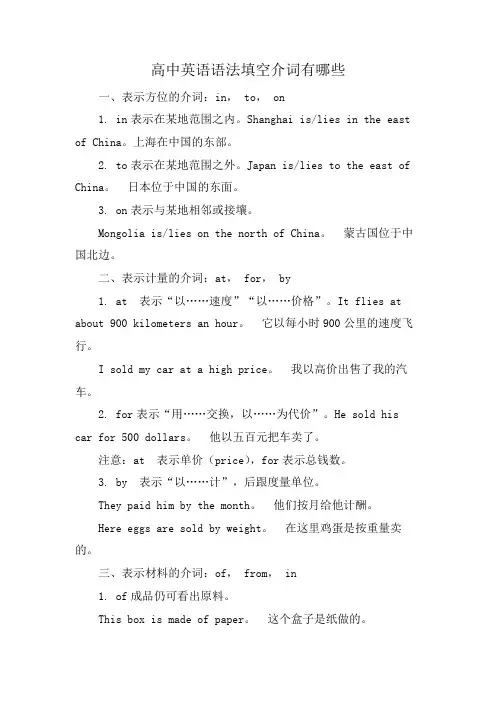
高中英语语法填空介词有哪些一、表示方位的介词:in, to, on1. in表示在某地范围之内。
Shanghai is/lies in the east of China。
上海在中国的东部。
2. to表示在某地范围之外。
Japan is/lies to the east of China。
日本位于中国的东面。
3. on表示与某地相邻或接壤。
Mongolia is/lies on the north of China。
蒙古国位于中国北边。
二、表示计量的介词:at, for, by1. at 表示“以……速度”“以……价格”。
It flies at about 900 kilometers an hour。
它以每小时900公里的速度飞行。
I sold my car at a high price。
我以高价出售了我的汽车。
2. for表示“用……交换,以……为代价”。
He sold his car for 500 dollars。
他以五百元把车卖了。
注意:at 表示单价(price),for表示总钱数。
3. by 表示“以……计”,后跟度量单位。
They paid him by the month。
他们按月给他计酬。
Here eggs are sold by weight。
在这里鸡蛋是按重量卖的。
三、表示材料的介词:of, from, in1. of成品仍可看出原料。
This box is made of paper。
这个盒子是纸做的。
2. from成品已看不出原料。
Wine is made from grapes。
葡萄酒是葡萄酿成的。
3. in表示用某种材料或语言。
Please fill in the form in pencil first。
请先用铅笔填写这个表格。
They talk in English。
他们用英语交谈。
四、表示工具或手段的介词:by, with, on1. by用某种方式,多用于交通。
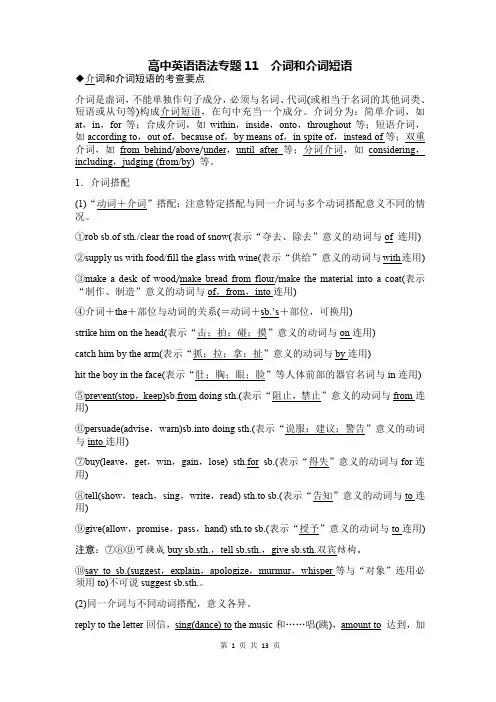
高中英语语法专题11 介词和介词短语◆介词和介词短语的考查要点介词是虚词,不能单独作句子成分,必须与名词、代词(或相当于名词的其他词类、短语或从句等)构成介词短语,在句中充当一个成分。
介词分为:简单介词,如at,in,for等;合成介词,如within,inside,onto,throughout等;短语介词,如according to,out of,because of,by means of,in spite of,instead of等;双重介词,如from behind/above/under,until after等;分词介词,如considering,including,judging (from/by) 等。
1.介词搭配(1)“动词+介词”搭配:注意特定搭配与同一介词与多个动词搭配意义不同的情况。
①rob sb.of sth./clear the road of snow(表示“夺去、除去”意义的动词与of 连用)②supply us with food/fill the glass with wine(表示“供给”意义的动词与with连用)③make a desk of wood/make bread from flour/make the material into a coat(表示“制作、制造”意义的动词与of,from,into连用)④介词+the+部位与动词的关系(=动词+sb.’s+部位,可换用)strike him on the head(表示“击;拍;碰;摸”意义的动词与on连用)catch him by the arm(表示“抓;拉;拿;扯”意义的动词与by连用)hit the boy in the face(表示“肚;胸;眼;脸”等人体前部的器官名词与in连用)⑤prevent(stop,keep)sb.from doing sth.(表示“阻止,禁止”意义的动词与from连用)⑥persuade(advise,warn)sb.into doing sth.(表示“说服;建议;警告”意义的动词与into连用)⑦buy(leave,get,win,gain,lose) sth.for sb.(表示“得失”意义的动词与for连用)⑧tell(show,teach,sing,write,read) sth.to sb.(表示“告知”意义的动词与to连用)⑨give(allow,promise,pass,hand) sth.to sb.(表示“授予”意义的动词与to连用)注意:⑦⑧⑨可换成buy sb.sth.,tell sb.sth.,give sb.sth.双宾结构。
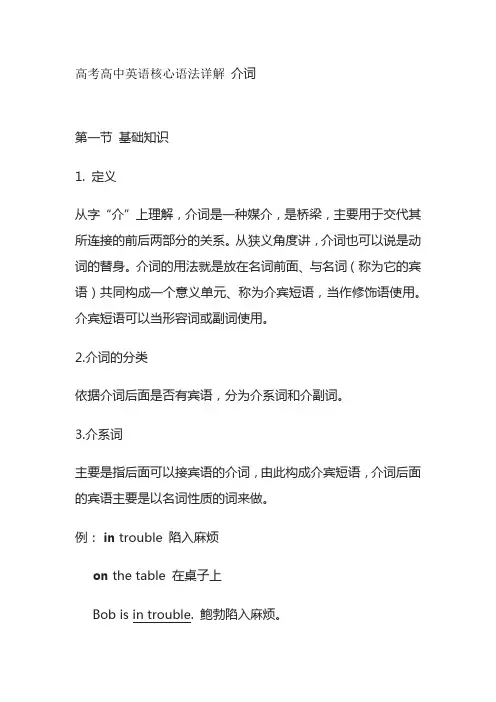
高考高中英语核心语法详解介词第一节基础知识1. 定义从字“介”上理解,介词是一种媒介,是桥梁,主要用于交代其所连接的前后两部分的关系。
从狭义角度讲,介词也可以说是动词的替身。
介词的用法就是放在名词前面、与名词(称为它的宾语)共同构成一个意义单元、称为介宾短语,当作修饰语使用。
介宾短语可以当形容词或副词使用。
2.介词的分类依据介词后面是否有宾语,分为介系词和介副词。
3.介系词主要是指后面可以接宾语的介词,由此构成介宾短语,介词后面的宾语主要是以名词性质的词来做。
例:in trouble 陷入麻烦on the table 在桌子上Bob is in trouble. 鲍勃陷入麻烦。
A red apple is on the table. 一个红苹果放在桌子上了。
4.介副词后面没有宾语,而是直接当副词使用。
Come in. 进来!The soldier stood up. 那名士兵站起来了。
5. 介副词和介词共同使用Mary went down to the basement. 玛丽去了地下室。
down 是介副词,后面没有宾语、直接修饰动词went;to 是介系词,后接名词词组the basement 当宾语、构成一个介词词组to the basement;went 看作不及物动词,后接介词to,再加宾语the basement;He has gone over to your office.over 是介副词,直接修饰动词has gone;to 是介词,后接名词词组your office 当宾语,构成一个介词词组to your office;gone看作不及物动词,后接介词to,再加宾语your office;第二节介系词在短语层面的应用介系词加宾语构成介宾短语后,主要出现在后修饰位置,其作用是交代中心词与其后的宾语之间的关系。
此时介宾短语也可视为形容词的性质。
例:a.2000 entry into the World Trade Organization2000年加入世贸b.an important earner of foreign exchange 赚取外汇的重要来源c. a boom in exports 出口增长第三节介系词在句子层面的应用1. 前状/后状:With the warm weather, the trees grow very well. 天气暖和,树木生长的很好!Kill two birds with one stone. 一石二鸟/一举两得。
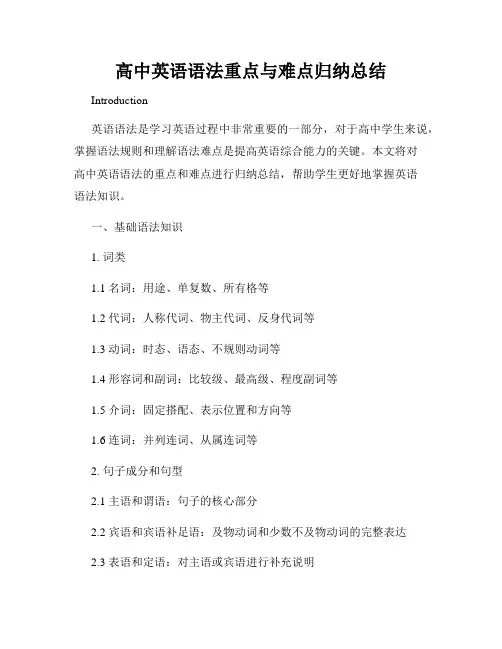
高中英语语法重点与难点归纳总结Introduction英语语法是学习英语过程中非常重要的一部分,对于高中学生来说,掌握语法规则和理解语法难点是提高英语综合能力的关键。
本文将对高中英语语法的重点和难点进行归纳总结,帮助学生更好地掌握英语语法知识。
一、基础语法知识1. 词类1.1 名词:用途、单复数、所有格等1.2 代词:人称代词、物主代词、反身代词等1.3 动词:时态、语态、不规则动词等1.4 形容词和副词:比较级、最高级、程度副词等1.5 介词:固定搭配、表示位置和方向等1.6 连词:并列连词、从属连词等2. 句子成分和句型2.1 主语和谓语:句子的核心部分2.2 宾语和宾语补足语:及物动词和少数不及物动词的完整表达2.3 表语和定语:对主语或宾语进行补充说明2.4 状语:修饰动词、形容词或副词的词组2.5 并列句和复合句:不同类型的句子结构及连接方式二、语法重点1. 时态和语态1.1 一般现在时:陈述事实、客观真理等1.2 现在进行时:表示正在进行的动作1.3 一般过去时:过去发生的动作或状态1.4 过去进行时:过去某一时间段内正在进行的动作1.5 一般将来时:未来发生的动作或存在的状态1.6 被动语态:强调动作的承受者而不是执行者2. 名词和代词2.1 可数名词和不可数名词:数量表达、单位转换等2.2 物主代词的使用:指示所有关系2.3 反身代词的使用:强调动作的自身承受者3. 冠词和形容词3.1 不定冠词和定冠词:特指或一般性描述3.2 形容词的用法:修饰名词、修饰人或物的特征等4. 副词和介词4.1 副词的比较级和最高级:程度或范围的描述4.2 介词的使用:表示方向、位置或时间关系等三、语法难点1. 条件句和虚拟语气1.1 条件句的种类和用法:一般条件句、真实条件句、虚拟条件句等1.2 虚拟语气的构成和用法:与现在事实相反、与过去事实相反等2. 定语从句和状语从句2.1 定语从句的引导词和使用:关系代词和关系副词的区别2.2 状语从句的种类和用法:时间、原因、条件、方式等3. 倒装和强调句3.1 部分倒装和完全倒装:句子结构的变换3.2 强调句的构成和用法:强调句子中的某一成分结论本文对高中英语语法的重点和难点进行了归纳总结。
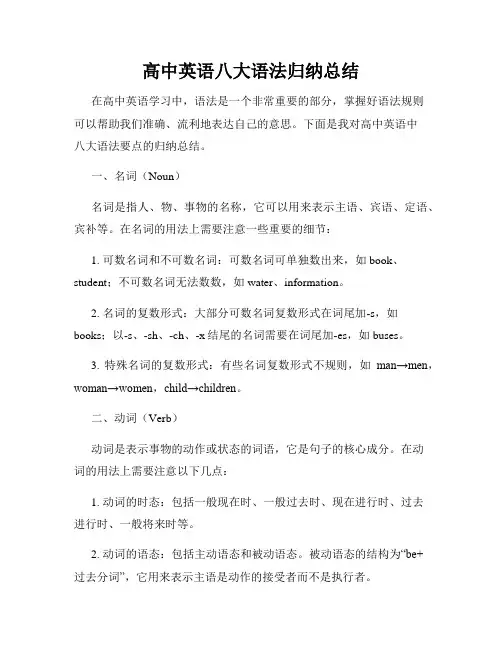
高中英语八大语法归纳总结在高中英语学习中,语法是一个非常重要的部分,掌握好语法规则可以帮助我们准确、流利地表达自己的意思。
下面是我对高中英语中八大语法要点的归纳总结。
一、名词(Noun)名词是指人、物、事物的名称,它可以用来表示主语、宾语、定语、宾补等。
在名词的用法上需要注意一些重要的细节:1. 可数名词和不可数名词:可数名词可单独数出来,如book、student;不可数名词无法数数,如water、information。
2. 名词的复数形式:大部分可数名词复数形式在词尾加-s,如books;以-s、-sh、-ch、-x结尾的名词需要在词尾加-es,如buses。
3. 特殊名词的复数形式:有些名词复数形式不规则,如man→men,woman→women,child→children。
二、动词(Verb)动词是表示事物的动作或状态的词语,它是句子的核心成分。
在动词的用法上需要注意以下几点:1. 动词的时态:包括一般现在时、一般过去时、现在进行时、过去进行时、一般将来时等。
2. 动词的语态:包括主动语态和被动语态。
被动语态的结构为“be+过去分词”,它用来表示主语是动作的接受者而不是执行者。
3. 动词的情态:情态动词用来表示说话人的语气、态度或观点,如can、may、must等。
三、形容词(Adjective)形容词用来修饰名词,描述事物的特征或性质。
在形容词的用法上需要注意以下几点:1. 形容词的比较级和最高级:形容词的比较级用于两者的比较,最高级用于三者或三者以上的比较。
2. 形容词的位置:形容词通常位于名词前面作为定语,但有时也可以位于系动词后面作为表语。
四、副词(Adverb)副词用来修饰动词、形容词、其他副词等,描述事物的程度、方式、时间等。
在副词的用法上需要注意以下几点:1. 副词的形式:大多数副词是在形容词词尾加-ly构成的。
2. 副词的位置:副词通常位于动词或形容词前面,修饰整个句子时位于句首或句尾。
1 on beneat
over past across
through
高中英语语法讲义——介词及介词短语 方位介词 (1)图解方位介词
如: The little mouse is under the table, so it is not easy to find it. The Great Wall winds its way from west to east, across deserts, over mountains, through valleys, till at last it reaches the sea. 用介词完成句子: 1.The sunlight came in _______ (穿过) the windows in the roof and lit up the whole room. 2. The bicycle is _______ (不能) repair. (2)among, between 一般来说,among用于三者及以上的“在…中间”,其宾语通常是一个表示笼统数量或具有复数(或集合)意义的名词或代词;而between指两者之间,其宾语常为表两者的名词或代词,或是由and连接的两个人或物。among在表示范围时,还可表示“在(其)中,…之一”。如: They hid themselves among the trees. She is the youngest among the three sisters. There was a fight between the two boys.
above over below under 2
I’m usually free between Tuesday and Thursday. 注意:在下列情况中,between可用于三者: ① 当两个以上的人或物用and连接时。如: between A, B, and C在A、B和C之间 ② 涉及人或事物之间的区别以及人或事物之间的关系时。如: the difference between the three of them the relations between various countries ③ 表示“由于…合作的结果”时。如: Between them they landed the fish. ④ 在divide, share等表示“分享”之类的动词之后,若接一个表示三者或三者以上的复数名词时,用among和between均可。如: He divided his money among/between his five ones. 用介词between, among填空 3. Some students often listen to music_______ classes to refresh themselves. 4. Four Chinese models were _______ the 14 people awarded prizes on Friday at World Supermodel Competition. (3)in, on 两者均可表示“在…上”,on侧重表面接触,in侧重接触的深度。若打击某人的脸、眼、嘴、 胸腹等部位用in,而打击头、额、鼻、耳、颈、肩、腿等部分用on。表示树本身生出来的 枝、叶、花、果等用on the tree,但在树本身以外的人或动物“在树上”,用in the tree,意指 被枝叶遮掩其中。如: We found a square hole in the wall. The teacher patted the boy on the head and comforted him. There are lots of apples on the tree. 用介词in, on填空 5. There is a map of the world______ the wall. 6. Birds are singing______ the tree. (4)across, through 均可表示穿过,但across与on有关,意为:from one side to the other side of sth,表示动作 在物体的表面进行,从一边到另一边。through与in有关,表示动作从物体中间穿过。 比较: He walked across the field.(在田野上) He walked through the forest.(在森林中) He ran across the bridge.(从桥上) He ran through the town.(贯穿) 此外,across与静态动词连用时表示“在(街、河等)…对面”或“在(身体某部位)上”的意思。如: The school is across the river. He has a giant scar across his chest. 用介词across, through填空 7. My house is just______ the street. 8. Water will be pumped______ a pipe. 9. Do you think this shirt is too tight______ the shoulders? (5)over, above, under, below 1)over和above都有“在…之上”的意思,但over表示“在…的正上方”,其反义词为under, 而above表示“在…的斜上方”,其反义词为below。over还可可表“(部分或全部覆盖)在…上面”的意思。如: You can’t wear a blue jacket over that shirt. It’ll look terrible. 2)over和above都可以表示在数量上“多于”的意思,但above一般用于表示与“最低限度”或“标 3
高中英语语法汇总及归纳总结大全一、名词(Nouns)名词是英语中最基本的词类之一,用于指代人、事物、概念等。
1. 可数名词(Countable Nouns):指代可以被数出的人或物,可用单数或复数形式。
例:There are three cats in the garden.(花园里有三只猫。
)2. 不可数名词(Uncountable Nouns):指代无法单独数出的物质、抽象概念等,只能用单数形式。
例:I need some water.(我需要一些水。
)二、代词(Pronouns)代词用来代替名词,以避免重复使用并提供句子的连贯性。
1. 人称代词(Personal Pronouns):代替人的名词。
例:He is my brother. (他是我的兄弟。
)2. 物主代词(Possessive Pronouns):表示所有关系。
例:This book is mine. (这本书是我的。
)3. 反身代词(Reflexive Pronouns):指反身动作的代词。
例:She hurt herself. (她伤到了自己。
)三、动词(Verbs)动词是表示一个行为、状态或事件的词。
1. 动词的时态(Verb Tenses):主要包括过去时、现在时和将来时。
例:She is reading a book. (她正在读一本书。
)2. 动词的语态(Voice):包括主动语态和被动语态。
例:The car was washed by John. (汽车是由约翰洗的。
)四、形容词(Adjectives)形容词用来描述或修饰名词或代词。
1. 形容词的级别(Degrees of Adjectives):包括原级、比较级和最高级。
例:This is a beautiful flower.(这是一朵美丽的花。
)2. 形容词的位置(Placement of Adjectives):一般放在名词前面。
例:They live in a big house.(他们住在一间大房子里。
介词介词是用于名词或代词之前、表示词与词之间关系的词类。
介词常与动词、形容词和名词搭配表示不同的意义。
表示时间关系的介词1. 表示时间段的介词(1) in, after“in+时间段”的名词词组表示从现在起往后推算一段时间,“after+时间段”表示从过去某时间往后推算一段时间。
例如:He'll return in three days/in three days' time.他三天后回来。
He left on Sunday and returned after three days.他星期日动身,三天后回来。
(2) in, within,duringin表示一段时间之内,within强调不能超过某段时间。
表示在一段特指的时间内,可用in或during,名词前通常有冠词、物主代词等限定词。
例如:The work was done in/within a week.这工作一周内就完成了。
The work was done during/in the holidays.这工作是假期里完成的。
表示年份、月份、季节用介词in。
例如:in 1990, in July, in summer。
in(3)during the(last+时间段for pastover表示在最近一段时间内,句中谓语动词通常用现在完成时。
She has been in London in the last few years.她最近几年一直在伦敦。
(4) for,overfor表示延续一段时间。
over表示贯穿一段时间。
例如:I'll study in the college for two years.我将在大学学习两年。
I hope they will stay over Christmas.我希望他们能过完圣诞。
2. 表示某一时间的介词(1) at, onat表示某一时刻,on表示某一天或日期。
例如:Shall we meet at 6:30?我们六点半见面好吗?The meeting will continue on Monday, April 1.会议四月一日,星期一继续进行。
高中英语语法知识点总结归纳大全在学习英语的过程中,掌握语法知识是非常重要的。
良好的语法基础能够帮助我们准确理解和表达英语,提高英语写作和口语能力。
本文将对高中英语语法知识点进行总结和归纳,帮助大家更好地理解和应用这些知识。
一、名词 (Noun)名词是指表示人、动物、事物、概念等的名称。
在句子中,名词通常用来作为主语、宾语、表语、定语和同位语。
根据其性质可分为可数名词和不可数名词。
可数名词可以单独使用或者加上数量词表示个体;不可数名词表示不可分割的抽象概念,通常没有复数形式。
二、代词 (Pronoun)代词用来代替名词并在句子中起到相同的作用。
常见的代词有人称代词、物主代词、反身代词、指示代词、不定代词等。
代词的正确使用能够避免重复使用名词,减少冗余。
三、动词 (Verb)动词是句子的核心,表示行为或状态。
根据动词的形式可以分为实义动词和系动词。
实义动词可以表示具体的动作或状态,而系动词用来连接主语和表语。
动词的时态和语态也是需要注意的重点。
四、形容词 (Adjective)形容词用来描述名词的性质、状态或特征。
通常形容词在句子中作为定语或表语使用。
形容词的比较级和最高级形式可以用来对比不同事物之间的差异。
五、副词 (Adverb)副词用来修饰动词、形容词、其他副词或整个句子。
副词可以对动词进行修饰,表示时间、地点、程度、方式等。
副词的使用能够使句子更具表达力和准确性。
六、介词 (Preposition)介词用来表示名词和其他词之间的关系,常常用来表示时间、地点、方式、原因等。
介词通常位于名词或代词之前,构成介词短语。
七、连词 (Conjunction)连词主要用来连接词语、短语、从句和句子。
常见的连词有并列连词、递进连词、转折连词、因果连词等。
运用恰当的连词能够使句子更加连贯和清晰。
八、冠词 (Article)冠词是一种特殊的限定词,包括定冠词和不定冠词。
定冠词"The"用来特指一个或已知的人或事物,不定冠词"A/An"用来表示泛指。
高中英语语法归纳总结高中英语语法归纳总结在学习英语的过程中,语法是一个非常重要的方面。
掌握英语语法规则可以帮助我们正确地表达和理解各种语言信息。
下面是一些高中英语语法的归纳总结,希望对你的学习有所帮助。
1. 时态:英语中有多种时态,包括一般现在时、一般过去时、一般将来时等。
时态的正确使用可以准确地描述动作发生的时间和状态。
记住各个时态的构成和用法是很重要的。
2. 名词:名词是指人、事物、地点或抽象概念的名称。
了解名词的单复数形式、所有格以及不同类型名词的用法是必要的。
另外,还需注意可数名词和不可数名词的区别。
3. 代词:代词用于替代名词,它们可以简化语言表达并避免重复。
了解主格、宾格、所有格和反身代词的用法是重要的。
此外,还需了解人称代词和指示代词的使用方式。
4. 形容词和副词:形容词用来描述名词的特征,而副词则用来修饰动词、形容词或其他副词。
掌握形容词和副词的比较级和最高级形式,以及其用法和位置是必要的。
5. 动词:动词是句子的核心,用于表示动作或状态。
了解动词的时态、语态、情态动词、不规则动词等方面的知识是重要的。
此外,还需注意动词的主谓一致和动词的正确使用。
6. 介词:介词在句子中用来表达时间、地点、方式等关系。
熟悉常见的介词和它们与名词、动词、形容词等之间的搭配是必要的。
7. 连词:连词用于连接不同的词、短语或句子。
了解并正确使用并列连词、从属连词和关联连词可以使句子结构更加丰富多样,并能够清晰地表达思想。
8. 句子结构:了解基本句型和复合句结构对于构建准确的句子非常重要。
学会使用主谓宾结构、倒装句、强调句等可以使你的语言表达更加灵活多样。
以上只是高中英语语法的一些基本归纳总结,实际上英语语法非常广泛而复杂。
在学习过程中,建议多进行语法练习,积累语法知识,并结合实际语境运用。
通过不断的练习和实践,你会逐渐提高自己的语法水平,使你的英语表达更加准确、流利。
“介词 + 关系代词”考点归纳余明朝陕西省商南县高级中学定语从句是高中英语重点语法项目之一, 也是高考必考项目之一。
纵观近几年的高考,不难发现“介词+关系代词”引导的定语从句是考查的热点。
下面就该结构引导的定语从句作一归纳总结,以便于考生更好地把握。
一、考点归纳:1. 用于这种结构的关系代词一般为which(指物)或whom(指人), 有时也用whose (指人或物)。
注意:介词后面不能跟关系代词that或who。
如:He will pay a visit to the house in which he was born twenty years ago.他要去参观20年前他出生的那座房子。
The gentleman about whom you told me yesterday proved to be a thief.你昨天跟我讲的那位先生没想到是小偷。
We entered the room, from whose window we could see the tower clearly.我们进了房间,从窗户处能清楚地看到宝塔。
2. 选用“介词+ 关系代词”结构中的介词时,要根据不同的语境、词组搭配、习语、惯用法等来决定,归纳起来介词的选择主要依据如下几点:①介词与定语从句的先行词是一种习惯性搭配。
如:The farm on which I once worked has taken on a new look.(on the farm)In his room, we saw a big table on which there were all kinds of books.(on the table)Yesterday we had a meeting at which we discussed many problems. (at the meeting)②介词与从句中动词是一种习惯性搭配。
高中英语语法归纳总结:介词
导读:本文高中英语语法归纳总结:介词,仅供参考,如果觉得很不错,欢迎点评和分享。
一、介词是高中英语语法中的一个细支
介词在高中英语语法中的作用不可小觑,虽然它只是高中英语九种词类之一。
而高中英语所有的语法项目概括起来就有45个,如下:五种基本句型。
两个语态和时态。
四种构词法:派生、合成、转化、缩略。
三个非谓语动词:现在分词、过去分词、不定式。
八种句子成分:主、谓、宾、定、状、补、表、同位语。
九种的词类:冠词、名词、代词、动词、副词、形容词、介词、连词、数词。
六种复合句:主语从句、宾语从句、表语从句、同位语从句、定语从句、状语从句。
七种其他情况:倒装,虚拟语气,强调句,省略句,祈使句,疑问句,there be句型。
上述那么多高中英语语法内容,并不是全部都要掌握,真正实用而且常考的内容不多,只要掌握其中核心的高中英语语法内容就行。
二、高中英语介词怎么复习
高中英语学习中,介词复习起来不难。
首先我们需要搞清楚有哪些介词,将介词全部做一个总结;在这些介词中,有哪些是你不太清楚或者能搞明白的,然后记录下来,针对性去找练习题做训练,然后区分各个相近用法介词之间的区别。
介词学习在高中英语中并不困难,只要用心一定能搞懂。
三、高中英语中常用的介词有哪些?
为了方便大家学习,我已经把高中英语中所有的介词用法总结好了,如下:
表示时间的at, in,on
(1)at:表示片刻的时间,at 8 o'clock,at midnight, at the beginning of, at the age of, at Christmas, at New Year 等。
(2)in:表示一段的时间,如in the morning, in the afternoon, in October,in the past等。
(3)on:总是跟日子有关,on Sunday, on Christmas morning,等。
表示时间的since 和from:
(1)since 表示从过去到现在的一段时间的过程,常与现在完成时连用.
(2)from 表示从时间的某一点开始,不涉及与现在的关系。
一般多与现在时、过去时、将来时连用。
如:I hope to do morning exercises from today.我希望从今
天开始每天做早操。
表示时间的in 和after:
两者都表示“在(某个时间)之后,区别在于in表示“在(一段时间)之后” ,而after 则表示“在(某一具体时间点之后),in 短语和将来时态连用,after 短语和过去时态或将来时态连用。
如:We'll leave in three days.我们3天内会离开。
After two months he returned.2个月之后他回来了。
表示“穿过……”的through 和across:through 表示从内部通过,与in 有关;across 表示“穿过……”,表示从一端至另一端在表面上的通过,与on 有关。
如:Water flows through the pipe.水从水管漏出来。
The old man walked across the street.这位老人走过街道。
表示地理位置的in, on, to:
(1)in 表示在某范围内;
(2)on 指与什么毗邻;
(3)to 指在某环境范围之外;
如:Changzhou is in the southeast of China.
Mongolia is on the north of China.
Japan is to the east of China.
表示“在……上”的on 和in:
on 只表示在某物的表面上;
而用in 表示占去某物一部分,表示……上;
如:There is a book on the piece of paper.纸上有本书。
There is an interesting article in the newspaper.报纸上有篇有趣的文章。
in the corner, on the corner, at the corner:in the corn 表示在落,in 指角的内面;on the corner 表示“在角上” ,on 指的不是内面,也不是外面,而含内外兼有之意;at the corner指“在拐角处” 指的是拐角外附近的外面。
如:I met at with him at the street corner.我在街角遇到他。
He sat on the corner of the table.他坐在桌子的一角。
in the end, at the end of, by the end of:in the end 作“最后”“终于”解,可单独使用,后不接介词of;at the end of 表示“在……末梢”“到……尽头” ,既可指时间,也可以指地上或物体。
不可单独使用;by the end of 作“在……结束时”“到……末为止”解,只能指时间,不可单独使用。
如:In the end they reached a place of safety.最后他终于到了安全的地方。
At the end of the road stands a beautiful garden.路的尽头有个美丽的花园。
They decided to have an English corner at the end of this week.这周为止他们决定办场英语角。
besides, except, but, except for:
besides 指除了……还有
如:All went out besides me
except 指“除了,减去什么” ,不能放在句首。
如:All went out except me.
but 与except 意思近似,表示“除了……外”经常用在no, all, nobody, anywhere, everything 等和其他疑问词后面。
如:I never saw him reading anything but the newspaper.;
except for 表示“如无……就,只是”表明理由细节。
如:His diary is good except for a few spelling mistakes.
表示“关于”的about 和on:两者都有“关于”的意思,不过前者为一般用词,而后者表示“关于” ,为较正式的“论述”
如:He came to tell me about something important.他过来告诉我一些重要的事情。
He wrote a book on science.他著有一本科学方面的书。
between, among:一般说来,between 表示两者之间,among 用于三者或三者以上的中间。
注意:但有时说的虽然是三个以上的人或东西,如果强调的是两两相互间接关系,适用于between。
而把它们视为分居两边时用between。
在谈事物间的差别时,总是用between。
表示“用”的in 和with:表示工具的“用” 、表示“ ,用with,而表示材料、方式、方法、度量、单位、语言、声音等的“用” 用in。
如:He is writing a letter with a pen./ He wrote the letter in pencil
We measured it in pounds./ Read the text in a loud voice./ Tell me the story in English.
in, into:into 表示动向,不表示目的地或位置。
如:We walked into the park.in 通常表示位置。
We walked in the park;
in 和drop, fall, put, throw, break 等终止性动词连用时,也可以表示动向。
如:I have put the coin in (into) my pocket.我把硬币放进衣袋。
以上就是关于高中英语中介词的语法知识。
其实很多介词的用法只要细细区分开来,就会发现其实并不难。
高中英语整体而言还是属于基础学习,等过了高中这个阶段,你就会发现其实真正的英语考试远比高中英语考试难度大多了。
高中生在高中阶段打好基础,日后若是有什么出国留学的想法,就可以为自己省了很多时间和金钱,希望今天的高中英语内容对你有帮助!。